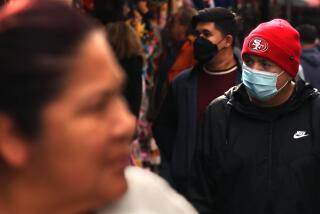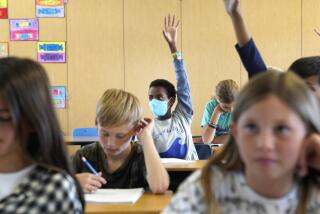California’s coronavirus curve is ‘bending,’ but tougher days are ahead, Gov. Newsom says

- Share via
SACRAMENTO — Nearly three weeks after ordering Californians to stay home, Gov. Gavin Newsom said Tuesday that the state’s efforts are slowing the spread of the novel coronavirus and “bending the curve.”
“Let me give you a sense of optimism, in terms of the curve in California bending: It is bending, but it’s also stretching,” Newsom said at a news conference.
Bending the curve means reducing the transmission of the virus to prevent a sudden and large spike of patients with COVID-19. Instead of a rapid surge, infections grow more gradually, essentially “stretching” out a bell curve over time, as Newsom said, to avoid overwhelming the healthcare system with more seriously sick patients than resources to treat them.
The Democratic governor expects tougher days ahead and a peak of sick patients in May.
Newsom is working with hospitals, healthcare providers and manufacturers to procure and staff 50,000 new hospital beds — in addition to the more than 70,000 currently in the state’s healthcare system — to adequately care for the anticipated rise in patients.
Severe cases of COVID-19 can cause fluid to build up in the lungs, leading to shortness of breath or difficulty breathing. Mark Ghaly, the state’s secretary of Health and Human Services, said he expects California to need 15,000 to 20,000 more ventilators, machines that push air in and out of the lungs, to care for seriously ill patients. The state currently has roughly 11,000 ventilators, Newsom said.
These are some of the unusual new scenes across the Southland during the coronavirus outbreak.
The governor provided few data points to support his assertion that California’s efforts are working.
Newsom reported a 10.7% daily increase in patients who have tested positive for COVID-19 to a total of 15,865 as of Tuesday. The governor reported gradual growth in hospitalizations from the virus to 2,611, up 4.1%, while patients receiving intensive care climbed just 2.1% to 1,108, he said.
The administration suspects another 2,796 Californians have been hospitalized with the virus, including 522 in intensive care, but are awaiting test results to confirm their diagnosis. Newsom said 374 Californians had died from COVID-19 as of Tuesday.
“These are not the double-digit increases we were seeing in hospitalization rates or ICU rates that we saw even a week or so ago,” Newsom said. “That’s not to suggest by any stretch of the imagination that we’ll continue to see these declines. It’s to only reinforce the importance of maintaining physical distancing and continuing our stay-at-home policy that has helped bend the curve in the state of California.”
“But that curve continues to rise, just not at the slope that originally was projected,” he added.
Newsom has repeatedly discouraged Californians from anticipating a return to their usual routines in the coming weeks, or for students to expect to resume in-person classes before summer break.
Newsom focused his press conference on concerns about mental health during a time of heightened stress and anxiety.
“Some people are coping quite well,” Newsom said. “Others are struggling, understandably, struggling because they lost their job. They don’t have a paycheck. Struggling because their kids aren’t in school. Struggling in a way where they’re having a hard time sleeping, where they’re a little bit shorter, or more irritable, and they’re prone to doing things that aren’t healthy.”
The governor said he tasked California Surgeon General Dr. Nadine Burke Harris with putting together a strategy to help support Californians and caregivers. He directed people to a state website and a seven-page guide to stress management, which includes suggestions to exercise, maintain supportive relationships at a distance, eat a balanced diet and phone numbers for crisis hotlines.
“The options we’re all taking to slow the spread of coronavirus — physical distancing hand washing, wearing masks and proper disinfecting — are critically necessary and remain the top priority, “ said Burke Harris, a San Francisco pediatrician. “But while we keep our physical distance, it’s our social support to maintain emotional, and spiritual connection are more important than ever for our physical and mental health.”
Burke Harris also raised a topic touched upon earlier Tuesday by U.S. Surgeon General Jerome Adams, who discussed health equity and said many African Americans are at higher risk of COVID-19.
Burke Harris took a moment to debunk what she described as a “terrible rumor circulating that for some reason African Americans don’t get coronavirus.”
“One of the pieces that we also recognize is that because of the true and unfortunate history of medical maltreatment of different groups of people, but especially African Americans in the United States, there are real issues of trust between the African American community and the healthcare system,” Burke Harris said.
She stressed the need for pastors, elders and other “trusted messengers” within communities of color to share the importance of physical distancing and staying home.
More to Read
Sign up for Essential California
The most important California stories and recommendations in your inbox every morning.
You may occasionally receive promotional content from the Los Angeles Times.













